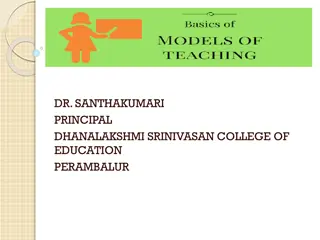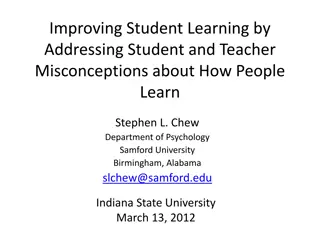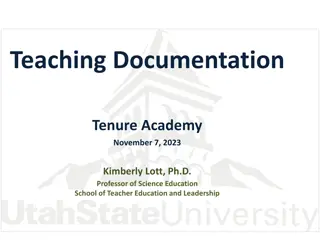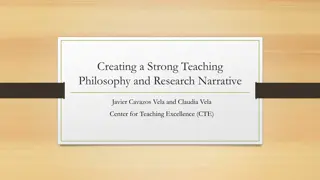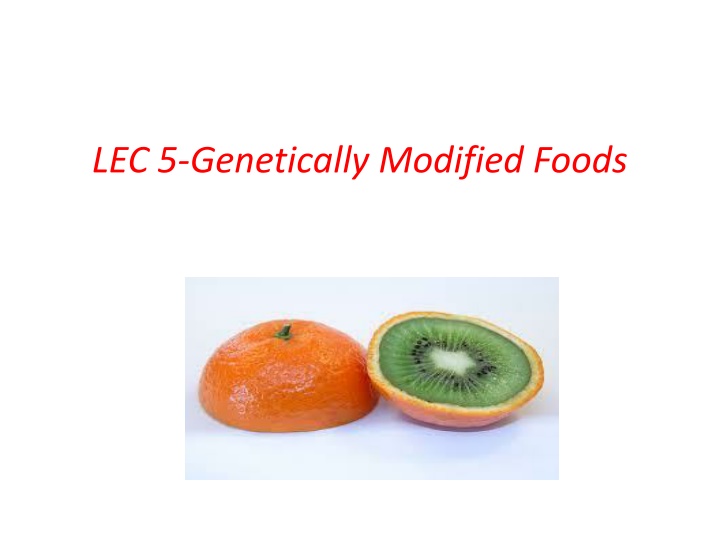
Exploring Genetically Modified Foods: GMOs, Benefits, and Examples
Genetically Modified Foods, also known as GMOs, are products derived from organisms with modified DNA through genetic engineering techniques. This article delves into the concept of GM foods, their advantages, including resistance to pathogens and herbicides, and presents notable examples like Golden Rice and Bt Corn. Discover the impact of genetic technology on food production and the traits introduced to enhance crop characteristics.
Download Presentation

Please find below an Image/Link to download the presentation.
The content on the website is provided AS IS for your information and personal use only. It may not be sold, licensed, or shared on other websites without obtaining consent from the author. If you encounter any issues during the download, it is possible that the publisher has removed the file from their server.
You are allowed to download the files provided on this website for personal or commercial use, subject to the condition that they are used lawfully. All files are the property of their respective owners.
The content on the website is provided AS IS for your information and personal use only. It may not be sold, licensed, or shared on other websites without obtaining consent from the author.
E N D
Presentation Transcript
Genetically modified foods or GM foods, also known as genetically engineered foods or bioengineered foods, are foods produced from organisms that have had changes introduced into their DNA using the methods of genetic engineering
Genetic engineering techniques allow for the introduction of new traits as well as greater control over traits than previous methods such as selective breeding and mutation breeding
. Genetically modified crops have been engineered for resistance to pathogens and herbicides and for better nutrient profiles
The March of Genetic Technology 1860 1920 1950 1960 1980 2000 Mendel: making crosses, introducing genes Discovery of hybrid vigor Inducing mutations Tissue culture and embryo rescue Plant transformation and GMOs Genomics
What are genetically modified foods? Also called genetically modified organisms (GMO). Involves the insertion of DNA from one organism into another OR modification of an organism s DNA in order to achieve a desired trait. 4 5 A strawberry resistant to frost + = Arctic fish DNA strawberry
What is a Genetically Modified (GM) Food? Foods that contain an added gene sequence Foods that have a deleted gene sequence Animal products from animals fed GM feed Products produced by GM organisms
Examples of GMOs Golden rice rice that contains beta-carotene (Vitamin A), which is not found in regular rice. Bt corn corn that contains a chemical normally found in a bacterium (Bacillus thuringiensis) that is toxic to insects but not to humans. Herbicide resistant plants.
Common GM Foods Vegetables Tomatoes Potatoes Rice Cheese Meat
How is genetic modification possible? The components of DNA are the same in all organisms. Sequences that code for proteins can be moved from one organism to another.
How can DNA be moved from one organism to another? Find an organism with the desired trait Isolate the gene sequence that codes for the desired trait Insert the gene sequence into the genome of the plant cell
How can DNA be moved from one organism to another? Allow the genetically altered cell to grow into a plant Allow the plant to propagate
How can DNA be moved from one organism to another? A vector can carry DNA. The vector can be a pellet from a gene gun. Viruses and bacteria also can be utilized to transfer genes.
Modifying Genes Also called recombinant DNA technology, molecular cloning, and genetic engineering. 1. Restriction enzymes are used to cut DNA segments from one genome. 2. DNA ligases are used to paste them into another genome. Foreign DNA
How are animals targeted? The microinjection method uses a fine needle to inject a solution of DNA into a developing embryo. 6
How are plants targeted? A particle gun is used to shoot small bits of metal coated with the gene into the plant. 7
Potential Benefits Humanitarian: Pest resistance Pest resistance Cheaper food Cheaper food Reducing world hunger and improving world Reducing world hunger and improving world health health Herbicide Herbicide resistance resistance Improved Improved farming farming More food More food Cold tolerance Cold tolerance Drought Drought tolerance tolerance Increased nutrition Increased nutrition Edible vaccines Edible vaccines Environmental: reduced use of chemicals in farming.
Potential Human Health Risks Allergens Genetic engineering could potential introduce or create allergens For example, inserting genes from a nut into another plant could be dangerous for people who are allergic to nuts Unknown health risks Biological processes involve a lot of INTERACTIONS It is often difficult to identify every possible interaction.
Are GM foods safe and nutritious? 1. All GM foods have been extensively tested and they are as safe as other foods in the market place. GM crops can be made into convenience and junk food just like organic crops and other crops! Nutrition depends on the food, not the method of crop breeding 2. 3.




